This post is all about making the right moves during math talk to help students gain the most from a mathematical discussion. Math talk moves are intentional decisions we make or encourage our students to make, which leads to more productive and meaningful mathematical conversations.
At 17 seconds remaining in the fourth quarter, Herman Boone calls a timeout.
He tells the quarterback, “Fake 25 blast with a backside George reverse.”
The overhead speaker booms as the announcer says, “The Titans take the field with time for one final play for the state championship.”
As the Titans enter the field, the Marshall High School coaches question why the Titans are bringing in a quarterback.
As the teams line-up, the Marshall coaches realize the Titans were about to run a trick play.
The coach yells “Cover deep, cover deep!”
But . . . it’s too late.
When the ball is snapped, the Titans’ quarterbacks run the ball down the field and into the endzone leading to the victory scene in Remember the Titans.
I can’t think of another job where reading your opponent is such an important skill. As a coach’s wife myself, I’ve watched my husband creating plays and watching videos to study his opponents’ habits.
Understanding your opponents’ habits helps coaches know how to respond and anticipate the moves their opponent will make.
Though our students are not our opponents, it’s important we make the right moves when it comes to orchestrating intentional math talk in the classroom.
How to Structure Mathematical Discussions
Much like a coach has a set group of plays to put into action when his/her opponent makes a certain move, there are some essential math talk moves to make during classroom discussions.
In Texas’s math standards, the Mathematical Process Standards include TEKS related to teaching students how to effectively communicate with each other. In fact, TEKS 1(G) of each grade level’s TEKS standards requires students to “display, explain, and justify mathematical ideas and arguments using precise mathematical language in written or oral communication.”
Teaching our students how to communicate is not just a Language Arts skill. We have to teach students how to communicate effectively in mathematics too.
Understanding math talk moves help to guide both students and teachers during a discussion. Modeling and using the moves during math talk will not only help students become better communicators but stronger math students as well.
Math Talk Moves
The authors of Intentional Talk share seven essential math talk moves. Each move is described in detail below.
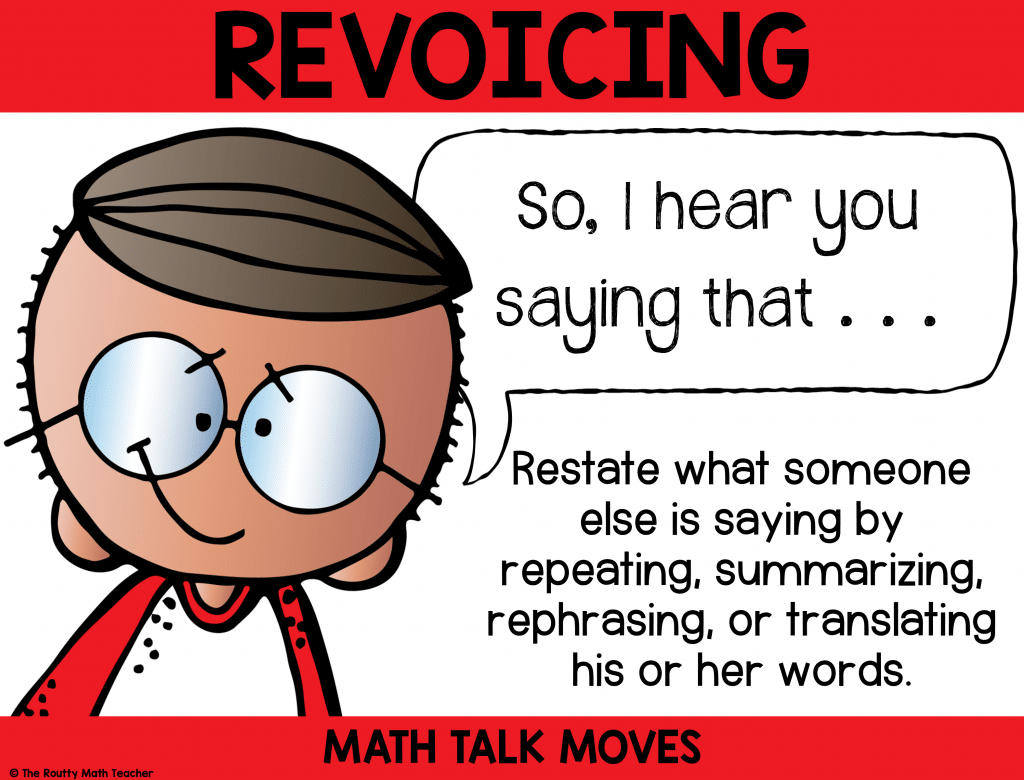
Revoicing
Teachers often use this strategy to help students better understand what another student shared during a discussion, but how often do our students use this move?
Revoicing means repeating a students’ words and asking the student to verify his/her thoughts were revoiced correctly. This move helps clarify or emphasize an idea or major point.
Over time, as students hear and see revoicing used in the classroom, they identify the most important elements of a conversation and select key points to remember and rephrase to increase their own understanding.
Related Sentence Stems:
- So, I hear you saying . . .
- This makes sense because . . .
- Another way to look at what _____ said is . . .
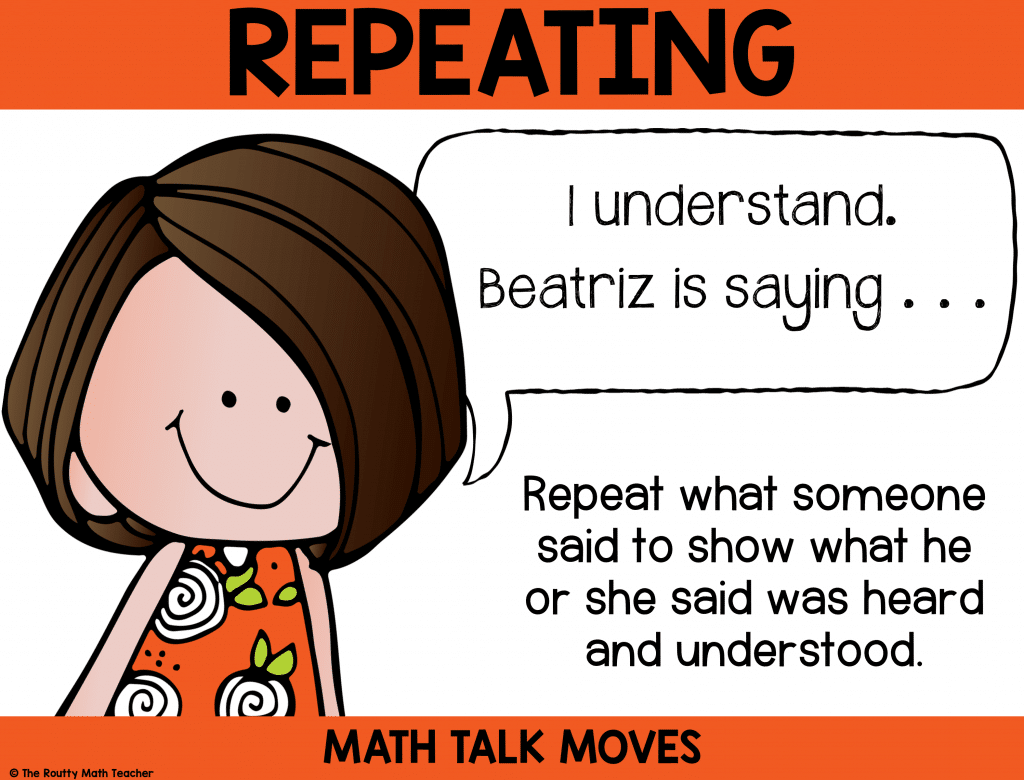
Repeating
Different from revoicing, students use this move to repeat or rephrase another speaker’s comments. This move helps to reiterate important ideas and can be used to slow down the conversation and offer processing time.
Teachers often use this move to emphasize an important point and ensure all students heard the student’s comments. When teachers ask other students to repeat what another student said, it’s often to help the individual student process the information, but it also offers other students a chance to hear the same information in another way since the comments will be rephrased in the new speaker’s own words.
Related Sentence Stems:
- So, I hear you saying . . .
- So, what you’re saying is . . .
- I heard you say . . .
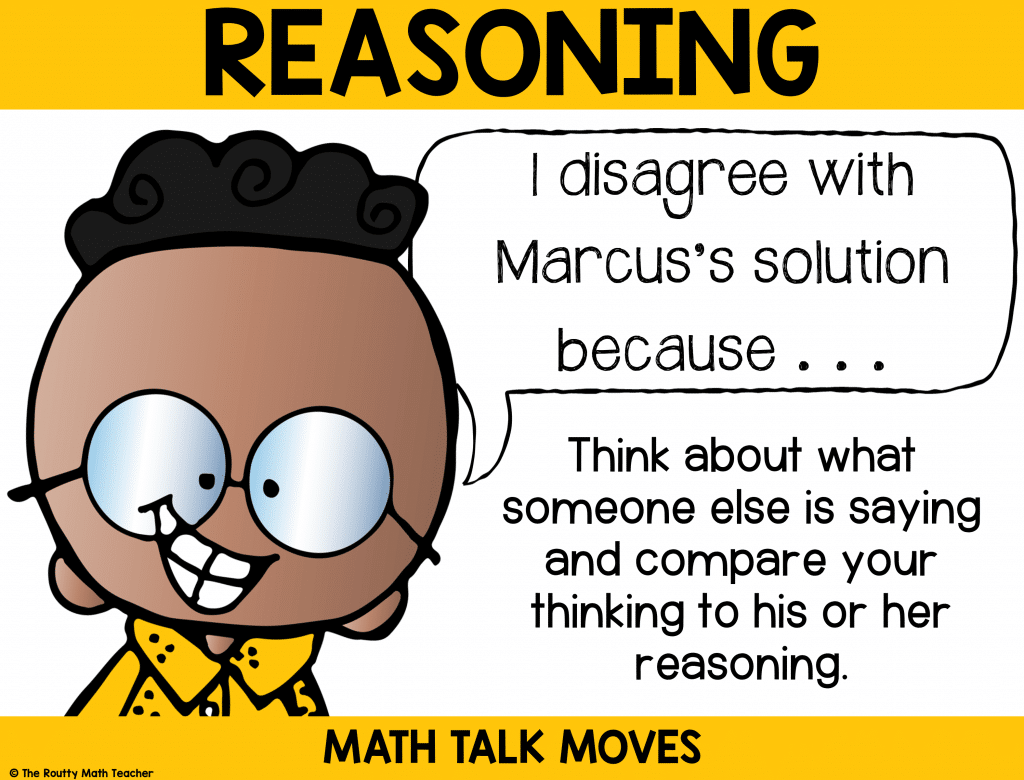
Reasoning
Once students process a classmate’s conjectures, asking students to compare their reasoning to another student’s reasoning is where the real magic happens because students have to analyze the other student’s reasoning before making the comparison and creating new connections.
This provides an opportunity to do a deep dive into student understanding while students reflect on, analyze, and make sense of the thinking of others. This move also provides an opportunity for students to learn to disagree respectfully.
Related Sentence Stems:
- I disagree with ______ because . . .
- I respectfully disagree because . . .
- I see it a different way. I think . . .
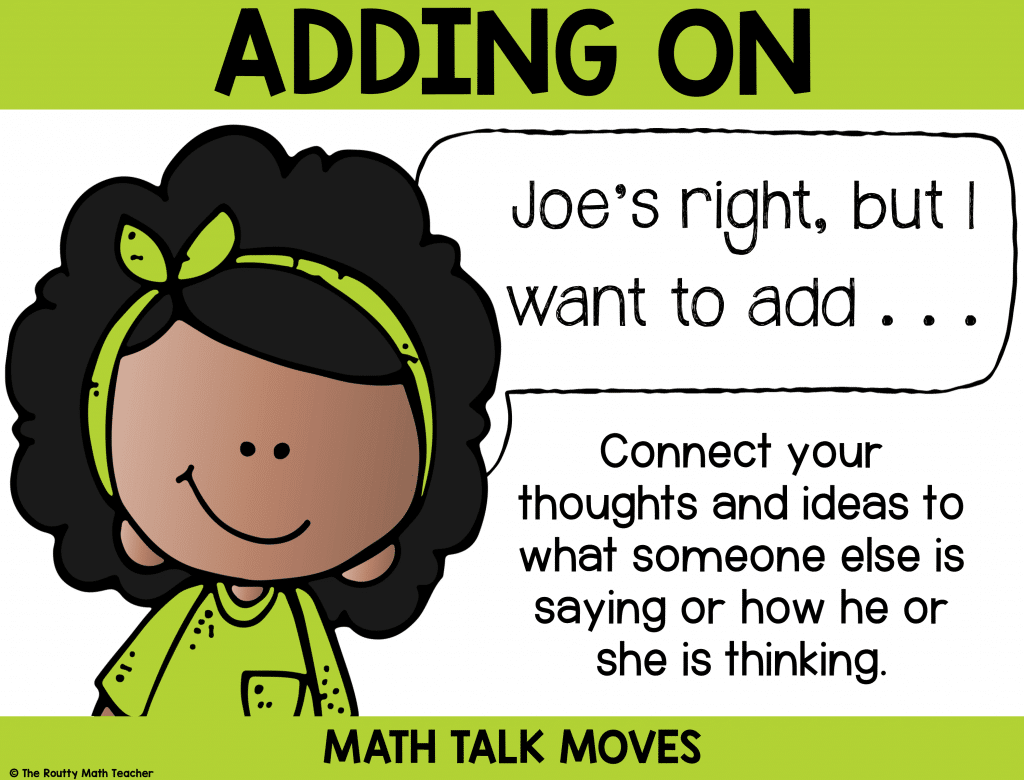
Adding On
Building on another students’ thinking or reasoning is another important move. Like the reasoning move, students must make sense of another students’ comments to do this successfully.
This move engages students in the conversation. Consider a time when only a few students shared during a discussion. When you use this move, you ask, “Would someone like to add to his/her thinking?
This move gives students a chance to connect to another student’s thinking— a higher level math skill.
Related Sentence Stems:
- I’d like to add . . .
- I used the same strategy, but I want to add . . .
- I can prove what ________ is saying is correct because . . .
- To piggy-back on what ______ said, . . .
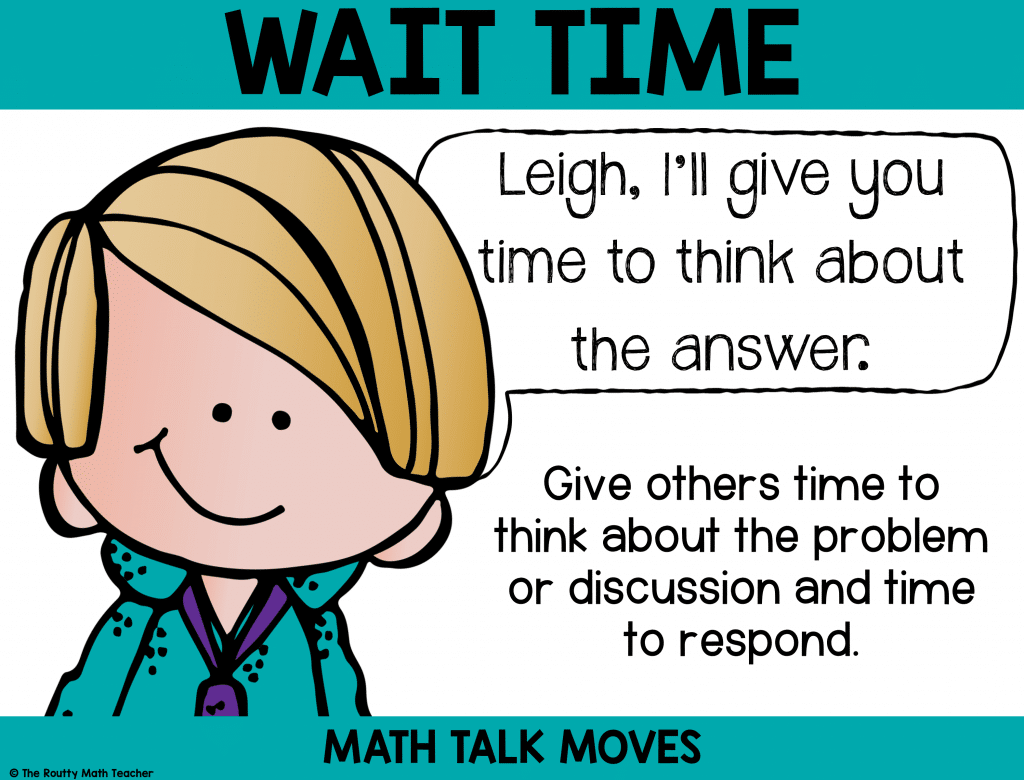
Wait Time
For many of us, me included, this is so hard! Silence is uncomfortable and feels unproductive, but oftentimes silence helps students make sense of a discussion and decide which move to make next.
Be sure to use this move when you first ask a question, as well as, when you call on a student so that he/she has time to collect and organize their thoughts. We teach our students to provide wait time to their partner or group members by naming and modeling this move. Once students understand the importance of wait time, they will be understanding of each other when it is needed, or requested, during small group discussions.
Related Sentence Stems:
- I’d like some time to think about . . .
- Can I have a moment to think?
- Take your time, ____________?
- I’ll give you time to think about . . .
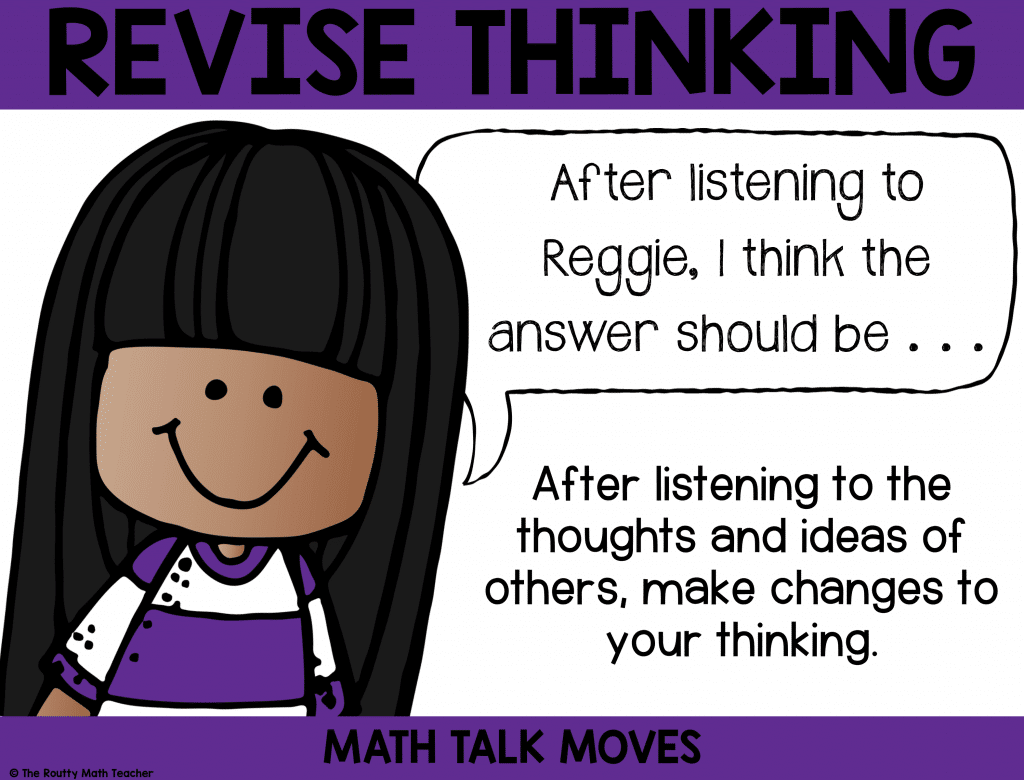
Revise Thinking
This is at the pinnacle of classroom discussions! When students revise their own thinking based on the reasoning of someone else, you’ve got a powerful discussion! We can encourage students to use this strategy by modeling it during classroom discussions.
For this move, students acknowledge their original thinking and articulate how and why it changed after gaining new insight from someone else.
Related Sentence Stems:
- After listening to ______, I think the answer should be . . .
- After seeing ______, I want to change my thinking to . . .
- I thought ______, but now I think . . .
- I’d like to revise my thinking.
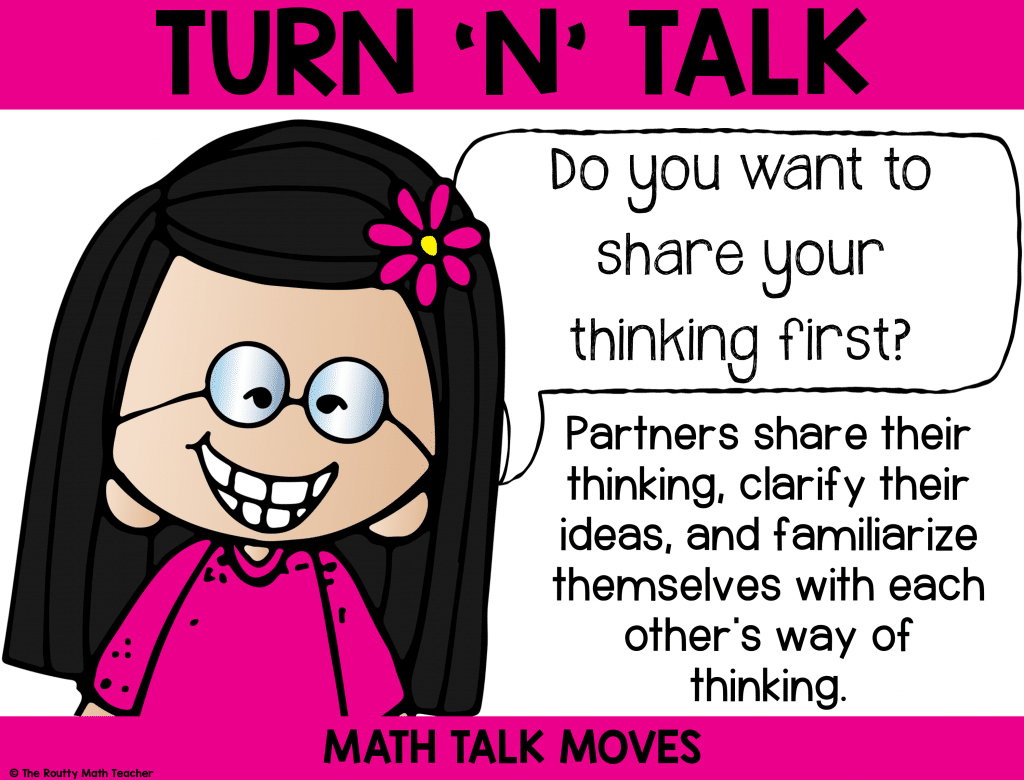
Turn-and-Talk
This move is not only a great strategy to use to give every student a chance to share his/her thinking and feel heard but also a chance for teachers to listen in on student conversations to determine which students to highlight during the large group discussion.
Many teachers use this strategy regularly; however, it’s important to teach students how to respond during a turn-and-talk session. Do students just listen and move on or do they practice revoicing, reasoning, or adding on in small group discussions? Turn-and-talk is a great structure to use to practice these moves.
Getting Started with Math Talk
In the same way we teach students how to communicate using formal language, we must teach them how to communicate mathematically too.
Here are some strategies for helping students learn to use the math talk moves in your next discussion.
1. Don’t overwhelm yourself or your students. Try introducing the moves one-at-a-time or naturally where they make sense in conversation.
2. When students use them, often unknowingly, be sure to highlight them to help students build the skill authentically and know when to use them in conversation.
3. After developing an understanding of the moves, allow students to decide how and when to use the moves in purposeful discussions.
4. Encourage students to use the moves in discussion and purposefully listen for them. Try recommending a move to use during daily discussions and celebrate students when you catch them using it.
Teaching virtually? Learn more about virtual communication tools to increase student-to-student communication here.
Want a nifty printable copy of the student moves you can use to help students better understand each move and its purpose? Use the form below to download the Math Talk Moves Poster.
Sound Off!
How do you help your students use math talk moves? Respond in the comments section below.
References
Kazemi, E. & Hintz, A. (2014). Intentional talk: How to structure and lead productive mathematical discussions. Stenhouse Publishers: Portland, Maine.
Credits:
Clipart courtesy of Melonheadz.






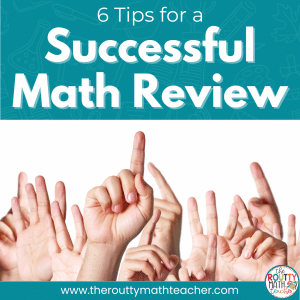
4 Responses
I cannot see where to download the Math Talk Moves Poster?
Hi Emily!
There should be a form for you to complete at the bottom of the post, but you can also find the form here: https://the-routty-math-teacher.ck.page/math-talk-moves-poster. Please email me at [email protected] if you have any other questions. Thank you!
~ Shametria
I LOVE THESE POSTERS. THEY ARE VERY HELPFUL!!
This site is so useful, well thought out, and necessary! Thank you for taking the time to cultivate the world of education. I very much appreciate this as an educator and administrator.